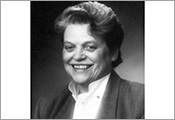It is with great sadness that we share the news of the passing of EMBL alumna Kathryn Howell, who died on 10 April 2020 at the age of 80.
The thoughts and sympathy of the EMBL community are with her family, friends and loved ones at this difficult time.
Kathryn joined EMBL as a group leader in 1981 in the Cell Biology Unit and was a vibrant member of the EMBL staff community until 1988. Kathryn combined expertise in organelle isolation and characterisation with molecular and imaging approaches to probe the mechanistic underpinnings of the secretory and endocytic pathways. In addition, Kathryn was a key figure in the development and application of tomography to study Golgi architecture and in utilizing proteomic approaches to identify Golgi components critical for its many activities. In addition to her many scientific accomplishments, Kathryn was an effective and inspirational leader, with deep commitment to mentoring fellows and students in her lab, as well as guide and advise junior colleagues. She was an exceptional colleague, always ready to help with a scientific question and discuss projects. Many benefitted from the excitement and commitment Kathryn brought to her scientific work.
Kathryn obtained a PhD in 1971 from Rutgers University, and initiated her post-doctoral training at Rockefeller University with the Nobel prize winner George Palade in 1972. She subsequently moved with the Palade group to Yale University in 1975. After completing her post-doctoral training, she was promoted to Instructor and in 1979 to Assistant Professor of Cell Biology at Yale. After only a year in that position, Kathryn was recruited to EMBL in 1980. After 9 years at EMBL, Kathryn accepted a position at the University of Colorado and moved to Denver in 1989, where she rose through the ranks, becoming a Full Professor in 1996.
Kathryn’s scientific accomplishments spanned a wide field, including major contributions to the development of novel affinity-based methods for isolating subcellular organelles that allowed the subsequent proteomic analyses of organellar components. Kathryn pioneered the advance of new assays to reconstitute in vitro vesicle budding from the TGN and endosomal fusion events, and used them to dissect sub-processes and identify novel regulatory molecules. Some of Kathryn’s most influential work was her HVEK analyses of the TGN and the Golgi stack that allowed the formulation and testing of different models of cargo passage and sorting in these compartments. Kathryn published outstanding work in all these areas, and the impact of her findings is reflected by the numerous and long-lasting citations of her papers. Kathryn was an active collaborator, and maintained long-term collaborations with many, including Richard McIntosh, John Caldwell and John Yates, III. Kathryn’s ability to combinne molecular, cell biological, tomographic and proteomic approaches to a scientific enigma was the most obvious and influential hallmark of her work.
Kathryn was an elected American Association for the Advancement of Science Fellowand was a member of the ASCB Council and chaired theASCB Image Collection. She was onnumerous Scientific Advisory and Editorial boards, and her expertise and fairness was well-known at numerous review panels for key funding agencies such as NIH and NSF.
While making fundamental contributions to science, Kathryn’s other major success was to nurture the next generation of researchers. She trained numerous students and fellows in her laboratory, many of whom are now leaders in their respective fields. Kathryn’s love of promoting scientific discovery was a major force in Kathryn organising numerous workshops and courses on Molecular Mechanisms of Intracellular Targeting and Sorting, sponsored by EMBL, ASCB, FEBS, Keystone and FASEB.
Many alumni and colleagues remember Kathryn for much more than her science. She was fun and kind and always eager to share her passion for Eskimo art, music and Chihuly glass. Remembrances of Kathryn often stress her directness and rigor (often initially extremely intimidating) and her eagerness to help, as well as her love of good food and drink! Elizabeth Sztul, a professor at UAB who was Kathryn’s first graduate student, remembers Kathryn: “She was both, a tough and demanding perfectionist and the most nurturing and caring mentor, and she had a fundamental influence on my professional and personal life”. A multitude of tributes and remembrances echo Kathryn’s importance to the membrane trafficking field and to the individuals whose lives she touched.
She will be missed by all who knew her.
The EMBL community share their tributes
Jean Salamero; Research Director (CNRS), Institut Curie
(EMBL Heidelberg Postdoc, Howell Group, 1987-1988)
It would be an understatement to say that Kathryn was an incredible mentor for me at EMBL and then in Denver. Warm, uncompromising, sometimes brittle but only to re-motivate. A support in doubt and a faithful friendship that surpasses time, distance, the breakdowns of life. I still remember, when a positive experience or the acceptance of an article enlightened our daily life, the interjection that characterised her so well, “Next Project !”
Tommy Nilsson; Director of Proteomics, The McGill University and Genome Quebec Innovation Centre
(EMBL Heidelberg Group Leader, 1995-2003)
Her splash at the Gordon Conference with the 3D Golgi will live on.
Graham Warren; Honorary Professor, UCL
(EMBL Heidelberg, Head of Unit and Senior Scientist, 1977-1985)
I remember her well. She was such a character, a breath of fresh air in the male-dominated halls of EMBL. She was such a good host when I visited her in Denver; I shall never forget the surreal experience (for an Englishman) of driving from the desert in the valley to the frozen lakes up high. Above all, I was really envious that she had a car with GOLGI as the number plate!
Condolences
If you would like to add a personal message of condolence, please contact the Alumni Relations team.
